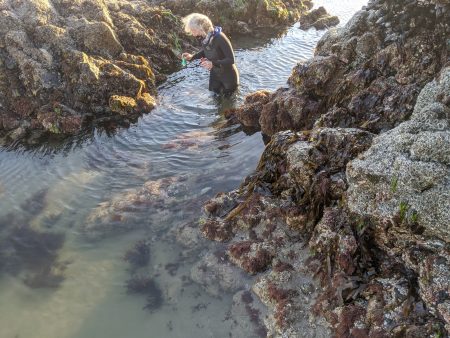
CANNON BEACH — Someone is stealing mussels off the iconic Haystack Rock.
Bald patches on the rock and nearby boulders have appeared after nighttime and evening low tides — after staff and volunteers with the city-run Haystack Rock Awareness Program have gone home.
In addition to the bare spots, volunteers and city staff have found evidence of mussel shucking and cleaning around the rock.
The poaching activities affect more than mussels.
The north boulders at Haystack Rock are where the awareness program conducts regular sea star surveys, tracking the recovery of the animals since the sea star wasting syndrome decimated populations along the West Coast beginning in 2013.
Sea star recovery has been uneven. At Haystack Rock, the awareness program is just now “barely seeing signs of recovery,” said director Kelli Ennis.
When she and other staff and volunteers are out at the rock during the day, interacting with visitors and keeping an eye on activities, they tell people to look among the mussel beds. That’s where you are most likely to see sea stars feeding. The beds also provide safe pockets where tiny young sea stars shelter from predators.
When poachers scrape mussels off the rocks, the worry is that they are inadvertently taking young sea stars, too.
“And if we’re losing juvenile sea stars to poaching, that’s horrendous, absolutely,” said Lisa Habecker, education and volunteer coordinator for the awareness program. During sea star surveys, she is the person in a wetsuit, wading into tide pools to count sea stars and look for ongoing signs of the wasting syndrome.
“The wasting syndrome took out 95% of our population of sea stars and now we have to worry about (poaching)?” Habecker said. She wonders how many young sea stars have wound up in the garbage or been cooked.
Haystack Rock, which can draw an estimated 200,000 visitors annually to Cannon Beach, is one of seven marine gardens in Oregon. Under this designation, the popular rock and its outlying areas are protected by the state. The harvesting of mussels — or collection of any plants or animals — from the rock and surrounding boulders is illegal. But it is not a new phenomenon.
Last summer, Habecker encountered one man — by all accounts, a local — who, along with several other people, had quickly filled three grocery bags with mussels collected from a boulder that volunteers call “Lonely Boulder,” on the south side of Haystack Rock.
When Habecker told the man he couldn’t harvest mussels there, the man pushed back. He said he thought he was far enough away from the big rock. Habecker later learned the man came down all the time to harvest mussels.
“In my 21 years of experience I always think I’ve seen it all, and then I’m proven wrong,” Habecker said. “It’s kind of laughable, but it’s also just crazy to me. It’s absolutely crazy to me to think: You can run down to Bell Buoy” — a seafood market in Seaside – “or to Costco and buy mussels. That they have to do it this way.”
The boundaries of the marine garden include not just the rocky areas in front of Haystack Rock exposed at low tide, but also the tide pools and sandy beaches that extend out in a 300-yard radius from the base of the rock — an area the size of about three football fields.
But Habecker and Ennis say few visitors they interact with seem aware of this. Mussel harvesting is permitted elsewhere along Oregon’s rocky shores and the signage around Haystack Rock is maybe not as prominent as it could be.
The purpose of the protections at the rock are to keep the site in peak ecological integrity.
“We’re really trying to show people what an undisturbed intertidal area that is rich in biodiversity really looks like,” Ennis said.
But she also knows mussels are a coveted delicacy and Haystack Rock’s boulders are enticingly accessible.
“It’s tempting to want to walk up to that rock and take some of those mussels,” Ennis said.
Aside from Habecker’s encounter last summer, the city doesn’t know who is taking the mussels and there isn’t much they can do about it. If awareness program staff or volunteers catch someone in the act, they can inform them of the marine garden’s protected status. They can’t issue a citation or arrest anyone.
The federal government has oversight of the upper portion of Haystack Rock because of birds like tufted puffins that nest there. The state is in charge of things below. Any enforcement of something like mussel poaching would need to come from the Oregon State Police’s fish and wildlife officers who already cover a large area and deal with issues on land and water alike.
The city is kind of on its own, City Manager Bruce St. Denis said.
In the city’s February newsletter, he wrote an open letter addressed “to whomever is going into the marine reserves at night (Haystack Rock, etc.) and stealing the live mussels for your dinner or party guests.”
He noted the ecological damage caused by the poaching, “that you do in the dark so you know what you are doing is wrong.”
He told KMUN he wanted the person — or people — to know the city was aware of what was happening. He also wanted to get the word out to others in the community and “get more eyes on it.”
Some locals have started monitoring the rock in the evenings and at night during low tides.
